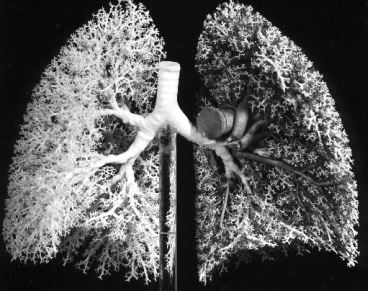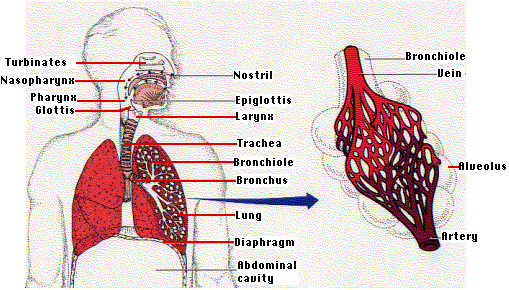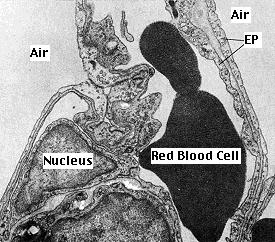
| Index to this page |
 |
| This photo (courtesy of the Anatomical Institute, Bern) shows a rubber cast of human lungs. |

Only in the alveoli does actual gas exchange takes place. There are some 300 million alveoli in two adult lungs. These provide a surface area of some 160 m2 (almost equal to the singles area of a tennis court and 80 times the area of our skin!).
The inner surface of the thoracic cavity and the outer surface of the lungs are lined with pleural membranes which adhere to each other. If air is introduced between them, the adhesion is broken and the natural elasticity of the lung causes it to collapse. This can occur from trauma. And it is sometimes induced deliberately to allow the lung to rest. In either case, reinflation occurs as the air is gradually absorbed by the tissues.
Because of this adhesion, any action that increases the volume of the thoracic cavity causes the lungs to expand, drawing air into them.The table shows what happens to the composition of air when it reaches the alveoli. Some of the oxygen dissolves in the film of moisture covering the epithelium of the alveoli. From here it diffuses into the blood in a nearby capillary. It enters a red blood cell and combines with the hemoglobin therein.
At the same time, some of the carbon dioxide in the blood diffuses into the alveoli from which it can be exhaled.
| Link to discussion of gas transport in the blood. |
| Composition of atmospheric air and expired air in a typical subject. Note that only a fraction of the oxygen inhaled is taken up by the lungs. | ||
| Component | Atmospheric Air (%) | Expired Air (%) |
| N2 (plus inert gases) | 78.62 | 74.9 |
| O2 | 20.85 | 15.3 |
| CO2 | 0.03 | 3.6 |
| H2O | 0.5 | 6.2 |
| 100.0% | 100.0% | |

The rate of cellular respiration (and hence oxygen consumption and carbon dioxide production) varies with level of activity. Vigorous exercise can increase by 20–25 times the demand of the tissues for oxygen. This is met by increasing the rate and depth of breathing.
It is a rising concentration of carbon dioxide — not a declining concentration of oxygen — that plays the major role in regulating the ventilation of the lungs. Certain cells in the medulla oblongata are very sensitive to a drop in pH. As the CO2 content of the blood rises above normal levels, the pH drops
[CO2 + H2O → HCO3− + H+],
and the medulla oblongata responds by increasing the number and rate of nerve impulses that control the action of the intercostal muscles and diaphragm. This produces an increase in the rate of lung ventilation, which quickly brings the CO2 concentration of the alveolar air, and then of the blood, back to normal levels.
| Link to a description of experiments that demonstrate this. |
However, the carotid body in the carotid arteries does have receptors that respond to a drop in oxygen. Their activation is important in situations (e.g., at high altitude in the unpressurized cabin of an aircraft) where oxygen supply is inadequate but there has been no increase in the production of CO2. People who live at high altitudes, e.g., in the Andes, have enlarged carotid bodies.
The smooth muscle in the walls of the bronchioles is very sensitive to the concentration of carbon dioxide. A rising level of CO2 causes the bronchioles to dilate. This lowers the resistance in the airways and thus increases the flow of air in and out.
| Link to discussion of allergic asthma. |
In this disorder, the delicate walls of the alveoli break down, reducing the gas-exchange area of the lungs. The condition develops slowly and is seldom a direct cause of death. However, the gradual loss of gas-exchange area forces the heart to pump ever-larger volumes of blood to the lungs in order to satisfy the body's needs. The added strain can lead to heart failure.
The immediate cause of emphysema seems to be the release of proteolytic enzymes as part of the inflammatory process that follows irritation of the lungs. Most people avoid this kind of damage during infections, etc. by producing an enzyme inhibitor (a serpin) called alpha-1-antitrypsin. Those rare people who inherit two defective genes for alpha-1-antitrypsin are particularly susceptible to developing emphysema.
Any irritant reaching the bronchi and bronchioles will stimulate an increased secretion of mucus. In chronic bronchitis the air passages become clogged with mucus, and this leads to a persistent cough. Chronic bronchitis is usually associated with cigarette smoking.
Irritation of the lungs can lead to asthma, emphysema, and chronic bronchitis. And, in fact, many people develop two or three of these together. This constellation is known as chronic obstructive pulmonary disease (COPD).
Among the causes of COPD areCystic fibrosis is a genetic disorder caused by inheriting two defective genes for the cystic fibrosis transmembrane conductance regulator (CFTR), a transmembrane protein needed to transport Cl− and HCO3− ions out of epithelial cells. In healthy lungs, secretion of Cl− (along with Na+ through a different channel) draws water by osmosis into the fluid bathing the cells. In cystic fibrosis, inadequate secretion of Cl− and the resulting lack of water produces a thick, sticky mucus covering the epithelia and hampering the ability of ciliated cells to move it up out of the lungs. The accumulation of mucus plugs the airways interfering with breathing and causing a persistent cough. It also provides ideal conditions for the invasion of pathogenic bacteria. Cystic fibrosis is the most common inherited disease in the U.S. white population.
| Some mutations that cause cystic fibrosis. |
Lung cancer is the most common cancer and the most common cause of cancer deaths in U.S. males. Although more women develop breast cancer than lung cancer, since 1987 U.S. women have been dying in larger numbers from lung cancer than from breast cancer.
| Link to lung cancer data. |
Lung cancer, like all cancer, is an uncontrolled proliferation of cells. There are several forms of lung cancer, but the most common (and most rapidly increasing) types are those involving the epithelial cells lining the bronchi and bronchioles.
Ordinarily, the lining of these airways consists of two layers of cells. Chronic exposure to irritants
| Link to illustrations of the cellular changes in developing lung cancer. |
| Welcome&Next Search |